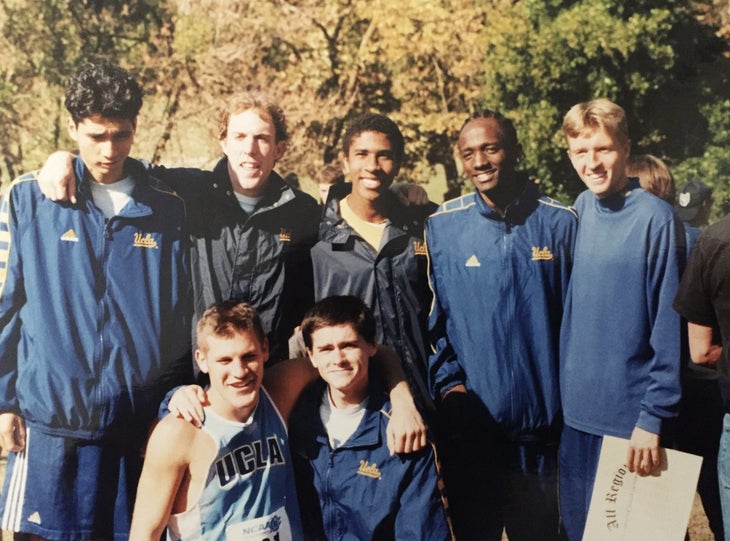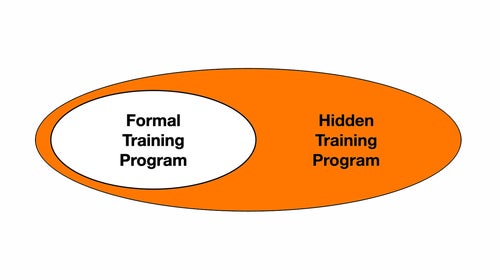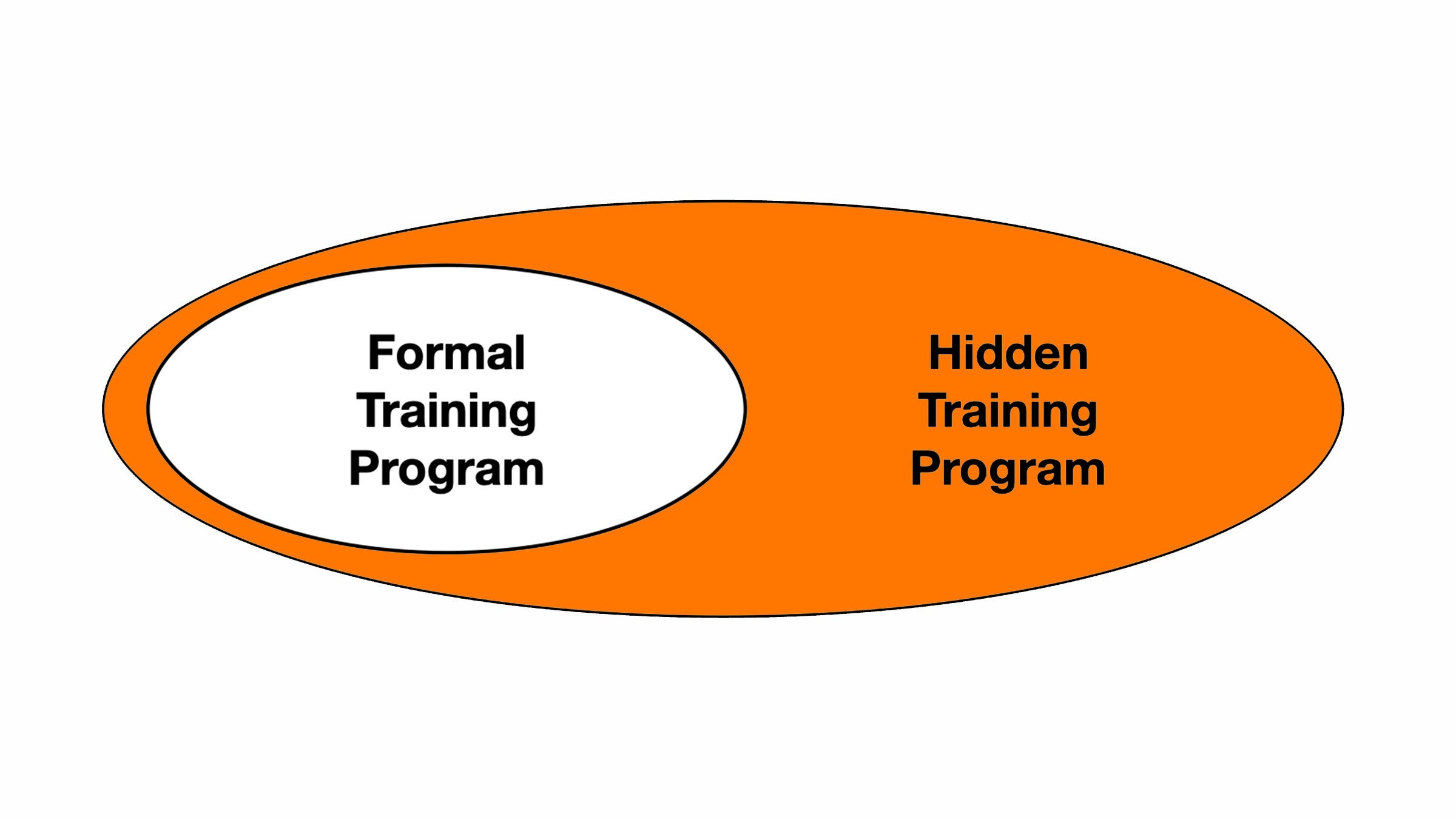Every athlete actually carries out two training programs. The first is their official, formal running training program, prescribed by a coach or adopted from a book or online plan. This is what is expected of you as a runner.
The second is the Hidden Training Program: everything you really need to do to be successful.
The Hidden Training Program includes the formal training program and much more. How you prepare before practice and recover afterward. How you eat and drink to maximize your energy. How you allocate your time to other responsibilities (school, work, family, partner). How you talk to your coaches to have productive conversations.
Success is about more than just showing up and working hard. You have to be ready to work hard when you show up!
Olympic 800 meter runner Khadevis Robinson once told me a story about how he approached eating when he was traveling in Europe. He would bring his own oatmeal and peanut butter from the US. He knew he could get oatmeal or peanut butter in Europe, but he wanted everything about his experience to be as predictable and consistent as possible.
Have you given any thought to your oatmeal or peanut butter recently? The best athletes have.

Whereas your formal training program is communicated directly, the Hidden Training Program is rarely communicated at all. It is learned through engagement: watching how others behave, seeing how people react to different situations, listening to how people talk, and identifying the routines that separate the best from the rest.
My uncle told me a story about his time running at Cal Poly San Luis Obispo in the early 1980s. They had a very strong team, and he was looking to improve so he could make the traveling squad.
He decided to go to the library to check out books on running and see if he could gain some insight or advantage. He checked out every book he could find. When he got home and looked at the little card indicating who had checked the books out before him, all the top runners on his team had already read the books!
Great runners are always fully engaged in their training. You will have to match their engagement to compete with them.
The Hidden Training Program also consists of all the unstated expectations of those around us. Not everyone on your team is making you better. They may not even realize it. But the expectations they set for you can help you or hinder you.
The best teams reinforce optimal training habits in every aspect of their day. In doing so, they reveal the Hidden Training Program more directly to new teammates, who quickly see that there is a specific way they will need to behave in order to succeed. This is the best case scenario, but unfortunately not every team has created an environment of excellence for new members to step into.

When I arrived at UCLA as a walk-on distance runner, I had no idea what I was doing. So I did what we all do in these situations: I copied what others did. But outside of practices, everybody did different things. At one end, Meb [Keflezighi] was insanely thorough and disciplined. We would joke that he wouldn’t spit without first considering whether it affected his training.
Then there was the rest of the team. Most guys drank and partied. Some did ultrasound treatments and massages before workouts, but others didn’t. After practice some guys did ice baths, some wrapped ice on sore muscles, and some skipped icing altogether. Some stretched well and others hardly at all. Some ate amazing amounts of food and others tried to eat healthy. Some guys did core work after practice and others did it at home or not at all. One or two pledged fraternities, a couple others had jobs, and a few others volunteered.
It was up to us as individuals to know what we needed and use the resources available. But I didn’t know what I needed. I’d never thought about any of this stuff before.
I sort of fell into the routine of the “other guys,” the non-elite members of the team. I followed their leads, but inconsistently. I stretched, but not purposefully. I iced, but only when it felt necessary. I did some sit-ups, sometimes, when I thought about it. I rarely asked the trainers for treatment because I felt embarrassed about it…surely better athletes needed their attention more.

I can see now that Meb understood — either explicitly or implicitly — the Hidden Training Program, and structured his entire life around it. Other guys either understood it but didn’t care as much, or (and I think this is more likely) didn’t understand it at all.
The formal training program and the resources available to athletes at UCLA was world-class. But the Hidden Training Program required athletes to be fully engaged, know what they needed, and take responsibility to get it. Some guys thrived. Others, like me, took more time to figure it out.
You can picture the Hidden Training Program as a kind of fog that obscures the negative forces and obstacles on the path to your goal. The more you expose it, the clearer the path to success will be. The more you allow it to stay hidden, the more likely you or your teammates will be slowed down by it.
If you want to be great, it’s not enough to do hard workouts. You have to think better, figure out your Hidden Training Program (it will differ for every person and team), and train at a high quality over a long time period.
- How purposefully are you practicing? Do you know why you are doing each of your training activities?
- How much are you sleeping? Is that enough?
- How much are you eating? Are you eating the right foods? Are you eating at the right times?
- How much are you stretching or doing other “maintenance” activities, like foam rolling, after workouts?
- Do you have non-training activities that are consuming too much of your time and energy? What can you do to find a better balance?
You can probably have some measure of success without worrying about all of these questions. But I can’t stress this enough: your competition will be thinking about every aspect of the Hidden Training Program. (Even the oatmeal.) And if you really want to be successful, you need to as well.
—
Excerpted and adapted from Make the Leap, a 2020 book about creating the momentum to achieve your goals by thinking better about your training.
About the Author
Bryan Green competed at UCLA from 1997 to 2002, was a two-time individual qualifier for the NCAA Cross Country Championships in 2000 and 2001, and ran a “3rd best PR” of 29:40 in the 10k. He has a Master’s in International Affairs from UC San Diego and spent ten years working as an analyst in Silicon Valley. He is currently the co-founder of Go Be More Apparel, host of the Go Be More and Fueling the Pursuit podcasts, and author of Make the Leap. His passion is sharing powerful ideas to help people go be more in life.


